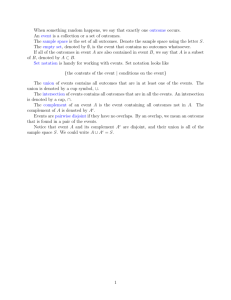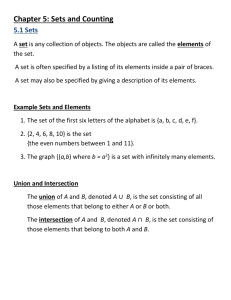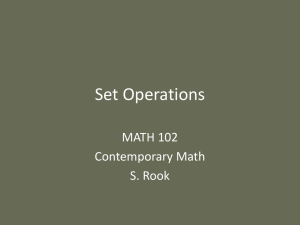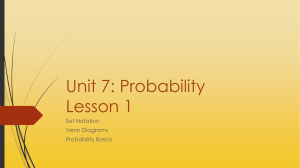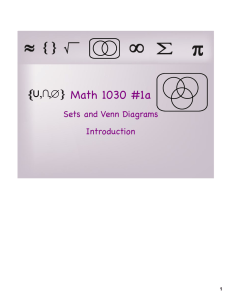Operations on Sets disjoint intersection
advertisement
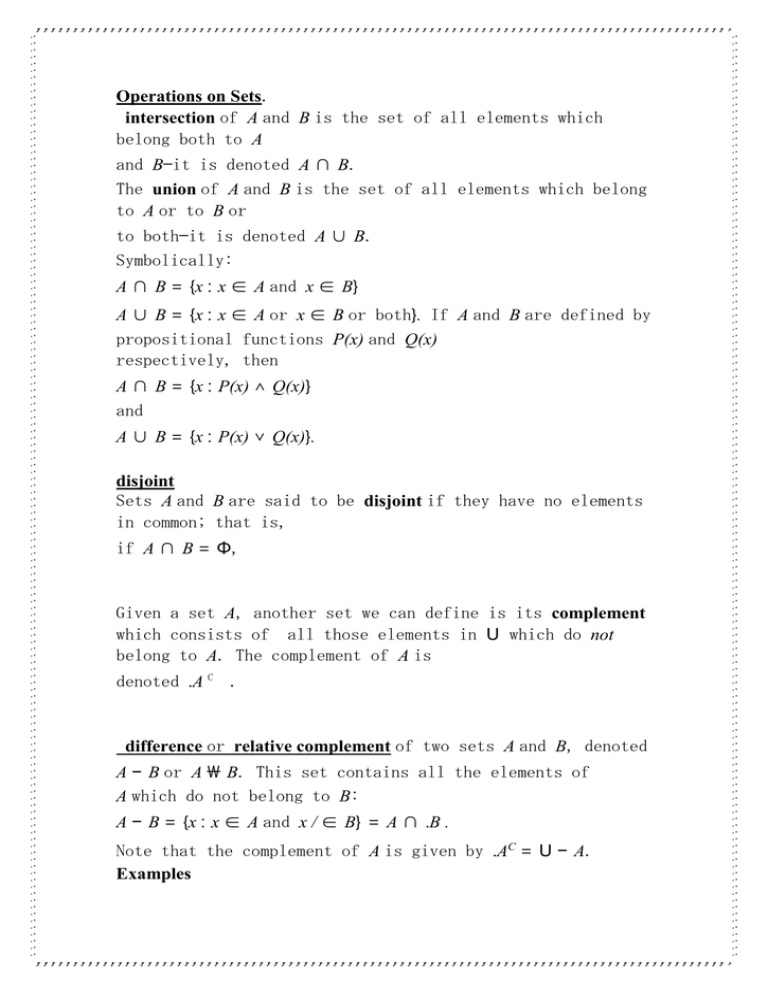
Operations on Sets.
intersection of A and B is the set of all elements which
belong both to A
and B—it is denoted A ∩ B.
The union of A and B is the set of all elements which belong
to A or to B or
to both—it is denoted A ∪ B.
Symbolically:
A ∩ B = {x : x ∈ A and x ∈ B}
A ∪ B = {x : x ∈ A or x ∈ B or both}. If A and B are defined by
propositional functions P(x) and Q(x)
respectively, then
A ∩ B = {x : P(x) ∧ Q(x)}
and
A ∪ B = {x : P(x) ∨ Q(x)}.
disjoint
Sets A and B are said to be disjoint if they have no elements
in common; that is,
if A ∩ B = Φ,
Given a set A, another set we can define is its complement
which consists of all those elements in U which do not
belong to A. The complement of A is
denoted .A C .
difference or relative complement of two sets A and B, denoted
A − B or A \ B. This set contains all the elements of
A which do not belong to B:
A − B = {x : x ∈ A and x / ∈ B} = A ∩ .B .
Note that the complement of A is given by .AC = U − A.
Examples
1. Let V = {1, 2, 3, . . . , 10}
A = {1, 2, 3, 4, 5, 6} and B = {3, 6, 9}.
Therefore:
A ∩ B = {3, 6}
A ∪ B = {1, 2, 3, 4, 5, 6, 9}
A − B = {1, 2, 4, 5}
B − A = {9}
.
AC = {7, 8, 9, 10}
. B C = {1, 2, 4, 5, 7, 8, 10}
A ∪ B = {7, 8, 10} = . AC ∩ . BC
A ∩ B = {1, 2, 4, 5, 7, 8, 9, 10} = . AC ∪ . B C
A − B = {3, 6, 7, 8, 9, 10}
2. (i) For each of the following, draw a Venn diagram and
shade the
region corresponding to the indicated set.
(a) A − (B ∩ C) (b) (A − B) ∪ (A − C).
(ii) Show that A−(B ∩C) = (A− B)∪(A−C) for all sets A, B
and
C.
Solution
Let A, B and C be sets.
First we show A − (B ∩ C) ⊆ (A − B) ∪ (A − C).
Let x ∈ A−(B∩C). Then x ∈ A and x / ∈ B∩C. Hence x ∈ A and
either
x / ∈ B or x / ∈ C (or both). Therefore either x ∈ A and x / ∈
B or x ∈ A
and x / ∈ C (or both). It follows that x ∈ A − B or x ∈ A − C
(or both).
Hence x ∈ (A − B) ∪ (A − C). We have shown that if x ∈ A − (B
∩ C)
then x ∈ (A−B)∪(A−C). Therefore A−(B∩C) ⊆ (A−B)∪(A−C).
Secondly we must show that (A − B) ∪ (A − C) ⊆ A − (B ∩ C).
Let x ∈ (A − B) ∪ (A − C). Then x ∈ A − B or x ∈ A − C (or
both) so
x ∈ A and x / ∈ B or x ∈ A and x / ∈ C (or both). Hence x ∈ A
and either
x / ∈ B or x / ∈ C (or both) which implies x ∈ A and x / ∈ B
∩C. Therefore
x ∈ A − (B ∩ C). We have shown that if x ∈ (A − B) ∪ (A − C)
then
x ∈ A − (B ∩ C). Therefore (A − B) ∪ (A − C) ⊆ A − (B ∩ C).
Finally, since we have shown that each set is a subset of
the other, we
may conclude (A − B) ∪ (A − C) = A − (B ∩ C).
Exercises
1. Draw Venn diagrams and shade the regions representing
each of the
following sets:
(i) .AC ∩ B
(ii) . AC ∪ B
(iii) (A ∩ B) ∪ (A ∪ B)
(iv) A ∩ (B ∪ C)
(v) A ∪ (B ∩ C)
(vi) (A ∩ B) − C
(vii) A − (B ∩ C)
(viii) (A ∪ B) − C
(ix) A − (B ∪ C)
(x) (A − B) ∩ (A − C).
2. Let � = {n : n ∈ � ∧ n < 10}, A = {2, 4, 6, 8}, B = {2, 3, 5, 7},
C = {1, 4, 9}. Define (for example, by listing elements) each
of the
following sets.
(i) A ∩ B (vi) A ∩ (B ∪ C)
(ii) A ∪ B (vii) BC ∪ B
(iii) A − B (viii) . BC ∩ B
(iv) B ∩ C (ix) A ∪ C
(v) . AC ∩ B (x) (A − C) − B.
3. Consider the sets A, B, C, D and E represented by the
following Venn
diagram. (The sets C and E are represented by shaded
regions.) For each
of the following pairs of sets X and Y , state whether X ⊆
Y , Y ⊆ X,
X ∩ Y = _ or none of these.
(i) X = A ∪B Y= C
(ii) X = A ∩B Y= D
(iii) X = A ∩B Y= C
(iv) X =E Y= A ∩ D
(v) X = B ∩C Y= C ∪ D
(vi) X = A ∩E Y= D ∪ E
(vii) X = C ∪E Y= A ∪ D
(viii) X = C −B Y= D ∪ E
(ix) X = A ∪D Y= B ∩ E
(x) X = A −E Y= A − D.
4. Let � = {1, 2, 3, . . . , 9, 10} and define sets A, B, C and D as
follows.
A = {2, 4, 6, 8, 10} B = {3, 4, 5, 6}
C = {7, 8, 9, 10} D = {1, 3, 5, 7, 9}.
List the elements of each of the following sets.
(i) A ∪ B
(vii) B.C ∩ .C
(ii) A ∩ D
(viii) A − (B ∩ .C C )
(iii) B ∪ C
C
(ix) (A − B) ∪ (D − C)
(iv) A ∩ (B ∪ D)
(x) D − C
(v) B ∪ ( . AC ∩ . DC )
(xi) ( . AC ∪ . BC ) − (A ∪ B)
(vi) (C ∩ D) ∪ B
(xii) ( .C − A) ∩ (A − . C C)
6. Given that A = {x : P(x)}
B = {x : Q(x)}
C = {x : R(x)}
define each of the following sets in terms of P(x), Q(x) and
R(x) (and
logical connectives):
(i) A ∩ .Bc
(ii) A ∪ B
(iii) A ∩ (B ∪ .Cc )
(iv) A − B
(v) A − (B ∪ C)
(vi) .A c− .B c.
The Algebra of Sets
union, complement (and hence difference) operations on sets
are related to one
another. For instance,
A ∩ B = .Ac ∪ .Bc
Idempotent laws
A∩ A= A
A∪ A= A
Commutative laws
A∩ B= B∩ A
A ∪ B = B ∪ A.
Associative laws
A ∩ (B ∩ C) = (A ∩ B) ∩ C
A ∪ (B ∪ C) = (A ∪ B) ∪ C.
Absorption laws
A ∩ (A ∪ B) = A
A ∪ (A ∩ B) = A.
Distributive laws
A ∩ (B ∪ C) = (A ∩ B) ∪ (A ∩ C)
A ∪ (B ∩ C) = (A ∪ B) ∩ (A ∪ C)
.
Involution law
..A
(AC )C= A.
De Morgan’s laws
(A ∪ B)C = .AC ∩ .BC
(A ∩ B )C = .A C∪ .B C.
Identity laws
A∪ Φ= A
A∩ U= A
A∪ U= U
A ∩Φ = Φ.
Complement laws
A ∪ .A C = U
A ∩ .A C = Φ.
ΦC = U
. U C = Φ.
.
Families of Sets
we defined the intersection and union of a collection of n
sets as
follows:
∩Ar = A1 ∩ A2 ∩ · · · ∩ An = {x : x ∈ Ar for each r = 1, 2, . . .
, n}
and
UAr = A1 ∪ A2 ∪ · · · ∪ An = {x : x ∈ Ar for some r = 1, 2, . . . ,
n}.

